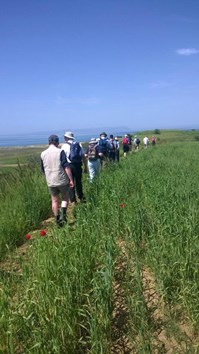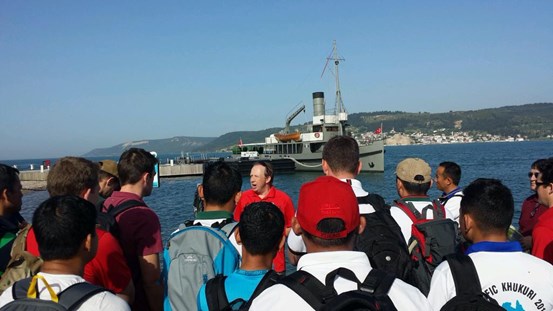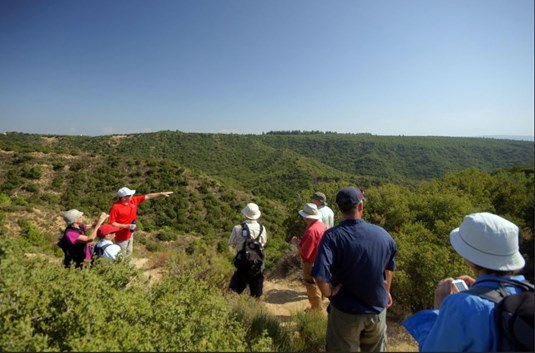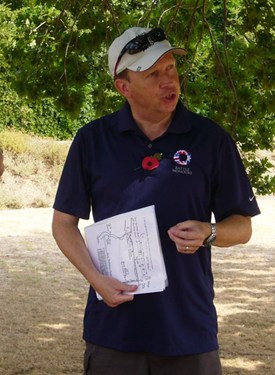A BATTLEFIELD LIKE NO OTHER
THE GALLIPOLI BATTLEFIELD
100 years on
Gallipoli is a battlefield like no other. Its historical significance in the FWW continues to attract visitors, but it’s natural beauty, Mediterranean weather and welcoming nature of the Turks adds to its appeal. Within this haunted ground, that once bore witness to battle 100 years ago, the terrain is nothing short of dramatic. With its changing topography, wild vegetation and harsh climate, these elements alone help a guide to explain the campaign, the what, the why’s and the what if’s. No documentary, film, book or photograph can explain any battlefield as well as being on the ground, and Gallipoli is no exception.
The build-up to the centenary has been very apparent, with a growing interest in the campaign that does not appear to be abating. Touring groups are increasing as the First World War continues to capture people’s imagination. Some may be researching a relative, have a passion for military history, or looking for a holiday with a difference, Gallipoli can be that destination. The peninsula, with its spectacular scenery; ridges, ravines, olive groves, figs and wild grapes, and the white sandy beaches that stretch almost endlessly along the Aegean shore, is a popular attraction. The islands of Bozcaada (Tenedos) and Gökçeada (Imbros), only a short ferry ride away, both served as forward bases for the Mediterranean Expeditionary Force and attract new visitors each year. Nearby Troy, where one can step back in time and examine another 4000 years of conflict, highlighting that the Dardanelles area has been the scene of recorded conflict since the days of King Xerxes when his pontoon bridge crossed the Narrows on his way to fight the Spartans. Alexander the Great roamed through the area on his way to the east and, more recent, the site where Attila the Hun defeated a Roman Eastern army. The whole area is beautiful, but also sacred. This ground not only contains the bones of the ancient dead, but also the FWW bones of over 100,000 men that fell here in 1915.

The Turk, Necmettin Halil Onan wrote a poem pertinent to the battlefield, the first verse is:
Stop wayfarer! Unbeknownst to you this ground You come and tread on, is where an epoch lies; Bend down and lend your ear, for this silent mound Is the place where the heart of a nation sighs.
In 1934 Turkish commander, Mustafa Kemal Atatürk, wrote a tribute to the mothers of the allied fallen,
Those heroes that shed their blood and lost their lives ... You are now lying in the soil of a friendly country. Therefore rest in peace. There is no difference between the Johnnies and the Mehmets to us where they lie side by side here in this country of ours ... You, the mothers who sent their sons from faraway countries, wipe away your tears; your sons are now lying in our bosom and are in peace. After having lost their lives on this land they have become our sons as well.
The centenary is a great time to discover the Gallipoli campaign, its epic battles and what the operation was all about, from the strategy, how the campaign was conceived and it’s flaws, through to the tactics and the struggle commanders had adapting to a modern industrialised war. No battlefield visit is complete without visiting the key sites and weaving the individual stories of those who fought. Gallipoli, like other battlefields, is rich with tales. Many have heard of the Private John Simpson Kirkpatrick, the ‘man with his donkey’ and Lance-Corporal Albert Jacka, the first Australian VC of the FWW. But stories of the lesser-known characters should also be covered, for example Captain Bob Bage, Antarctic explorer and Commander Edward Cater, the man with the monocle. One cannot talk nautical heroes without relating the story of Commander Edward Unwin and the six naval VCs. On the subject of decorations who cannot mention the famous Lancashire Fusiliers ‘Six VCs before Breakfast’ or that of Lieutenant Colonel Charles Doughty-Wylie, whose colourful story of bravery, adventure and love can be partnered with the mystery of who was the only woman to visit Gallipoli during the campaign. The list of characters is almost endless; the key is bringing history to life!
The battlefield itself is not one, but four; comprising of the Dardanelles, Anzac, Suvla and Helles. At Anzac the North Beach Commemorative Site and Anzac Cove are good places to relate the Anzac landings story, as is the stone monolith at Ari Burnu where visitors can read in silence the words of Atatürk. There are rewarding views everywhere, from Plugges Plateau to Chunuk Bair. On the Shell Green slopes one can tell tales of Cricket, then via Lone Pine walk the second ridge to trace the old Anzac perimeter. By Johnston’s Jolly you can trace parts of the original frontline trenches, where you do not have to go far from the track to find numerous reminders of war; shell craters, tunnels, barbed wire and other debris of war. As the road narrows, to the width of what was once No-Man’s-Land, a walk via the Posts: Steeles, Courtney’s and Quinn’s, will take you to the 57th Regiment Memorial and its Turkish symbolic cemetery. One cannot leave Anzac without visiting The Nek, the scene from the Peter Weir film where the Australian Light Horse attacked on 7 August 1915, or to watch an Aegean sunset from Walker’s Ridge.

Anzac is the most popular battlefield visited in Gallipoli, but it is no less spectacular in scenery or rich in history than Suvla or Helles. The Turkish Martyrs Memorial, which stands triumphantly above S Beach and Morto Bay, is a good place to start. The beautifully kept CWGC cemeteries cannot be missed as they tell so many stories of battle, courage and loss. One will notice few identified burials, a Gallipoli commonplace, which succinctly evokes the carnage and the chaos of the campaign, and a battlefield scattered even today with countless thousands of unknown graves. The Helles Memorial to the Gallipoli campaign, which also contains the names of 21,000 British missing, stands majestically on Cape Helles, overlooking the old battlefield area. All around are the landing sites, which include V Beach nestled by the ruins of Seddulbahir castle, and W Beach, better known as Lancashire Landing, which is still littered with 1915 period piers, dugouts and wrecked lighters. Walks along Gully Ravine are as rewarding as those through Kereves Dere in the French sector. Old Turkish redoubts still scar the landscape as do mine craters, shell holes and the trenches that remain still to this day. You can still walk Krithia Nullah, tracing the site of the infamous Vineyard and climb inside the dugouts along Observation Ridge. Up at Suvla the landing beaches are still perfectly preserved, as are the trenches on Lala Baba, Chocolate Hill, Hill 60 and all along the Kiretch Tepe ridge. The Salt Lake, now permanently open to the sea, remains, as does the Tekke Tepe ridge that still towers high above the Suvla plain.
The Gallipoli centenary year really began on 18 March 2015, a hundred years to the date that Admiral de Robecks’ combined Anglo-French fleet was prevented by the Ottomans from forcing the Dardanelles. Although not a well-known date outside of modern day Turkey, 18 March has become a major event in the Turkish national calendar. For the Turks this is the date they celebrate, not commemorate, the Gallipoli campaign, known in Turkish as Çanakkale Savaşı. It was the day the Ottoman combined defences of the Dardanelles; forts, minefields, mobile howitzer batteries and shore-based torpedo’s, brought to a standstill the might of the Royal Navy and French fleet. Visiting the forts is a must, and to view modern day shipping passing by, one can see what sitting ducks the fleet was. To quote Lord Nelson, a ship’s a fool to fight a fort. From these powerful fortifications one can understand why.

Outside of Turkey, 25 April is Anzac Day, one of the most important dates in both Australian and New Zealand national commemorative calendars, marking the anniversary of their first major military action and a place that helped foster their sense of national identity. But it is not just about Anzac. A growing number of British visitors now come to Gallipoli, and this year many assembled for the 24 April international commemorations at Helles. During late April, May and June many came to commemorate the Krithia battles, and in August the focus will be Suvla and the Sari Bair assault. I would also be surprised if no one turned up to coincide their visit with the evacuations. People will not stop visiting when the centenary comes to an end, and I am sure that this immortal ground will remain firmly lodged in remembrance and battlefield study for many years to come.
Stephen Chambers.
Note: First published in the International Guild of Battlefield Guides 'Despatches' journal, 2015.

